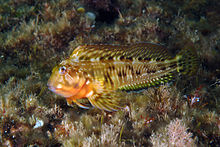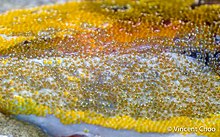| Combtooth blennies | |
|---|---|

| |
| Scartella cristata | |
| Scientific classification | |
| Domain: | Eukaryota |
| Kingdom: | Animalia |
| Phylum: | Chordata |
| Class: | Actinopterygii |
| Order: | Blenniiformes |
| Suborder: | Blennioidei |
| Family: | Blenniidae Rafinesque, 1810 |
| Subfamilies | |

Combtooth blennies are blenniiformids; percomorph marine fish of the family Blenniidae, part of the order Blenniiformes. They are the largest family of blennies with around 401 known species in 58 genera. Combtooth blennies are found in tropical and subtropical waters in the Atlantic, Pacific and Indian Oceans; some species are also found in brackish and even freshwater environments.
Description
The body plan of the combtooth blennies is archetypal to all other blennioids; their blunt heads and eyes are large, with large continuous dorsal fins (which may have three to 17 spines). Their bodies are compressed, elongated, and scaleless; their small, slender pelvic fins (which are absent in only two species) are situated before their enlarged pectoral fins, and their tail fins are rounded. As their name would suggest, combtooth blennies are noted for the comb-like teeth lining their jaws.
By far the largest species is the eel-like hairtail blenny at 53 cm in length; most other members of the family are much smaller. Combtooth blennies are active and often highly colourful, making them popular in the aquarium hobby.
Habitat and behaviour

Generally benthic fish, combtooth blennies spend much of their time on or near the bottom. They may inhabit the rocky crevices of reefs, burrows in sandy or muddy substrates, or even empty shells. Generally found in shallow waters, some combtooth blennies are capable of leaving the water for short periods during low tide, aided by their large pectoral fins which act as "feet". Small benthic crustaceans, mollusks, and other sessile invertebrates are the primary food items for most species; others eat algae or plankton.
One exceptional group of combtooth blennies deserves special mention: the so-called sabre-toothed blennies of the genera Aspidontus, Meiacanthus, Petroscirtes, Plagiotremus, and Xiphasia. These blennies have fang-like teeth with venom glands at their bases. Species of the genera Aspidontus and Plagiotremus (such as the false cleanerfish) are noted for their cunning mimicry of cleaner wrasses: by imitating the latter's colour, form, and behaviour, the blennies are able to trick other fish (or even divers) into letting down their guard, long enough for the blennies to nip a quick mouthful of skin or scale.

Some combtooth blennies form small groups, while others are solitary and territorial. They may be either diurnal or nocturnal, depending on the species. Females lay eggs in shells or under rock ledges; males guard the nest of eggs until hatching.

In some species, the eggs may remain in the oviduct of the female until hatched. The fry of some species undergo an 'ophioblennius' stage, wherein the fish are pelagic (i.e., inhabiting the midwater) and have greatly enlarged pectoral fins and hooked teeth.
Classification

This family is currently divided into two subfamilies and approximately 58 genera and 397 species.
The following genera are classified within the family Blenniidae:
- Subfamily Salarinae Gill, 1859
- Aidablennius Whitley, 1947
- Alloblennius Smith-Vaniz & Springer, 1971
- Alticus Lacepède, 1800
- Andamia Blyth, 1858
- Antennablennius Fowler, 1931
- Atrosalarias Whitley 1933
- Bathyblennius Bath, 1977
- Blenniella Reid, 1943
- Chalaroderma Norman, 1944
- Chasmodes Valenciennes, 1836
- Cirripectes Swainson, 1839
- Cirrisalarias Springer, 1976
- Coryphoblennius Norman, 1944
- Crossosalarias Smith-Vaniz & Springer, 1971
- Dodekablennos Springer & Spreitzer, 1978
- Ecsenius McCulloch, 1923
- Entomacrodus Gill, 1859
- Exallias Jordan & Evermann, 1905
- Glyptoparus J.L.B. Smith, 1959
- Hirculops J.L.B. Smith, 1959
- Hypleurochilus Gill, 1861
- Hypsoblennius Gill, 1861
- Istiblennius Whitley, 1943
- Lipophrys Gill, 1896
- Litobranchus Smith-Vaniz & Springer, 1971
- Lupinoblennius Herre, 1942
- Medusablennius Springer, 1966
- Microlipophrys Almada, Almada, Guillemaud & Wirtz, 2005
- Mimoblennius Smith-Vaniz & Springer, 1971
- Nannosalarias Smith-Vaniz & Springer, 1971
- Ophioblennius Gill, 1860
- Parablennius Miranda Ribeiro, 1915
- Parahypsos Bath, 1982
- Paralticus Springer & Williams, 1994
- Pereulixia J.L.B. Smith, 1959
- Praealticus Schultz & Chapman, 1960
- Rhabdoblennius Whitley, 1930
- Salaria Forsskål, 1775
- Salarias Cuvier, 1816
- Scartella Jordan, 1886
- Scartichthys Jordan & Evermann, 1898
- Stanulus J.L.B. Smith, 1959
- Subfamily Blenniinae Rafinesque, 1810
- Adelotremus Smith-Vaniz & Rose, 2012
- Aspidontus Cuvier, 1834
- Blennius Linnaeus, 1758
- Enchelyurus Peters, 1868
- Haptogenys Springer, 1972
- Laiphognathus J.L.B. Smith, 1955
- Meiacanthus Norman, 1944
- Oman Springer, 1985
- Omobranchus Valenciennes, 1836
- Omox Springer, 1972
- Parenchelyurus Springer, 1972
- Petroscirtes Rüppell, 1830
- Phenablennius Springer & Smith-Vaniz, 1972
- Plagiotremus Gill, 1865
- Spaniblennius Bath & Wirtz, 1989
- Xiphasia Swainson. 1839
Timeline

See also
References
- Sepkoski, Jack (2002). "A compendium of fossil marine animal genera". Bulletins of American Paleontology. 363: 1–560. Archived from the original on 2009-02-20. Retrieved 2011-05-19.
- J. S. Nelson; T. C. Grande; M. V. H. Wilson (2016). Fishes of the World (5th ed.). Wiley. p. 348. ISBN 978-1-118-34233-6. Archived from the original on 2019-04-08. Retrieved 2019-02-23.
- Froese, Rainer; Pauly, Daniel (eds.). "Family Blenniidae". FishBase. February 2013 version.
- Smith-Vaniz, W.F. & Rose, J.M. (2012): Adelotremus leptus, a new genus and species of sabertooth blenny from the Red Sea (Teleostei: Blenniidae: Nemophini). Zootaxa,3249: 39–46.
| Fish | |||||
|---|---|---|---|---|---|
| About fish |  | ||||
| Anatomy and physiology | |||||
| Sensory systems | |||||
| Reproduction | |||||
| Locomotion | |||||
| Other behaviour | |||||
| By habitat | |||||
| Other types | |||||
| Commerce |
| ||||
| Major groups | |||||
| Lists | |||||